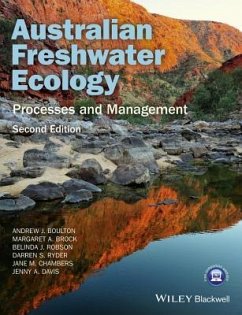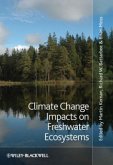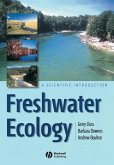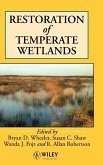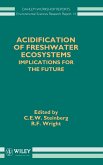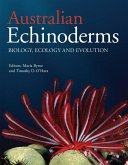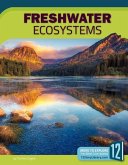Andrew Boulton, Margaret Brock, Belinda Robson, Darren Ryder, Jane Chambers, Jenny Davis
Australian Freshwater Ecology
Processes and Management
Andrew Boulton, Margaret Brock, Belinda Robson, Darren Ryder, Jane Chambers, Jenny Davis
Australian Freshwater Ecology
Processes and Management
- Gebundenes Buch
- Merkliste
- Auf die Merkliste
- Bewerten Bewerten
- Teilen
- Produkt teilen
- Produkterinnerung
- Produkterinnerung
As pressures on Australia's inland waters intensify from population growth, expanding resource development and climate change, there is an urgent need to manage and protect these special areas. Understanding their ecology underpins their wise management and conservation. Australian Freshwater Ecology vividly describes the physical, chemical and biological features of wetlands, lakes, streams, rivers and groundwaters in Australia. It presents the principles of aquatic ecology linked to practical management and conservation, and explains the causes, mechanisms, effects and management of serious…mehr
Andere Kunden interessierten sich auch für
![Climate Change Impacts on Freshwater Ecosystems Climate Change Impacts on Freshwater Ecosystems]() Climate Change Impacts on Freshwater Ecosystems121,99 €
Climate Change Impacts on Freshwater Ecosystems121,99 €![Freshwater Ecology Freshwater Ecology]() Gerry ClossFreshwater Ecology128,99 €
Gerry ClossFreshwater Ecology128,99 €![Restoration of Temperate Wetlands Restoration of Temperate Wetlands]() Restoration of Temperate Wetlands423,99 €
Restoration of Temperate Wetlands423,99 €![Acidification of Freshwater Ecosystems Acidification of Freshwater Ecosystems]() Acidification of Freshwater Ecosystems583,99 €
Acidification of Freshwater Ecosystems583,99 €![Einführung in die Limnologie Einführung in die Limnologie]() Jürgen SchwoerbelEinführung in die Limnologie44,99 €
Jürgen SchwoerbelEinführung in die Limnologie44,99 €![Australian Echinoderms Australian Echinoderms]() Australian Echinoderms146,99 €
Australian Echinoderms146,99 €![Freshwater Ecosystems Freshwater Ecosystems]() Tammy GagneFreshwater Ecosystems29,99 €
Tammy GagneFreshwater Ecosystems29,99 €-
-
-
As pressures on Australia's inland waters intensify from population growth, expanding resource development and climate change, there is an urgent need to manage and protect these special areas. Understanding their ecology underpins their wise management and conservation. Australian Freshwater Ecology vividly describes the physical, chemical and biological features of wetlands, lakes, streams, rivers and groundwaters in Australia. It presents the principles of aquatic ecology linked to practical management and conservation, and explains the causes, mechanisms, effects and management of serious environmental problems such as altered water regimes, eutrophication, salinization, acidification and sedimentation of inland waters. Key features: * contributions from a diverse, highly qualified team of aquatic ecologists whose expertise spans the ecology and management of standing and running waters in Australia * sections covering groundwaters, biodiversity, temporary and tropical waters, climate change, invasive species and freshwater conservation * numerous Australian case-studies and guest 'text-boxes' showing management in practice * concise descriptions of ecological processes and conceptual models illustrated with original, high- quality diagrams and photographs Readable and logically structured, this text supports undergraduate and postgraduate courses in aquatic ecology and management. It is a valuable reference for consultants, restoration ecologists, water resource managers, science teachers, and other professionals with an interest in the ecology of surface and groundwaters.
Hinweis: Dieser Artikel kann nur an eine deutsche Lieferadresse ausgeliefert werden.
Hinweis: Dieser Artikel kann nur an eine deutsche Lieferadresse ausgeliefert werden.
Produktdetails
- Produktdetails
- Verlag: Wiley
- 2nd edition
- Seitenzahl: 400
- Erscheinungstermin: 27. Mai 2014
- Englisch
- Abmessung: 246mm x 188mm x 23mm
- Gewicht: 998g
- ISBN-13: 9781118568231
- ISBN-10: 1118568230
- Artikelnr.: 40720381
- Herstellerkennzeichnung
- Libri GmbH
- Europaallee 1
- 36244 Bad Hersfeld
- gpsr@libri.de
- Verlag: Wiley
- 2nd edition
- Seitenzahl: 400
- Erscheinungstermin: 27. Mai 2014
- Englisch
- Abmessung: 246mm x 188mm x 23mm
- Gewicht: 998g
- ISBN-13: 9781118568231
- ISBN-10: 1118568230
- Artikelnr.: 40720381
- Herstellerkennzeichnung
- Libri GmbH
- Europaallee 1
- 36244 Bad Hersfeld
- gpsr@libri.de
Andrew J. Boulton, University of New England, Armidale, Australia Margaret A. Brock, University of Tasmania, Tasmania, Australia Belinda J. Robson, Murdoch University, Murdoch, Australia Darren S. Ryder, University of New England, Armidale, Australia Jane M. Chambers, Murdoch University, Murdoch, Australia Jenny A. Davis, University of Canberra, Canberra, Australia
About this book
xi About the companion website
xii PART I: PROCESSES IN AQUATIC ECOSYSTEMS
1 1 Australian waters: diverse
variable and valuable
3 1.1 The challenge for aquatic ecologists
3 1.2 Defi ning some common terms
6 1.3 Australian inland waters: their diversity and distribution
6 1.4 The water regime: 'where
when and to what extent water is present'
7 1.4.1 Water budgets
scale issues and human influences on water regimes
7 1.4.2 Components of the water regime
8 1.4.3 Water regime variability
9 1.5 Linkages in aquatic ecosystems: from molecular bonds to global exchanges
11 1.5.1 Wonderful water and its molecular linkages
11 1.5.2 Linkages at the catchment scale
12 1.5.3 Linkages at the global scale: the hydrological cycle
13 1.5.4 Continental linkages and surface waters in Australia
15 1.5.5 Continental linkages and groundwaters in Australia
19 1.6 The structure of this book
20 2 Physical processes in standing waters
21 2.1 Depth and physical processes
21 2.2 Let there be light ...
21 2.2.1 Light reaching the water surface
21 2.2.2 Light below the water surface
22 2.2.3 Seeing through water: Secchi discs and quantum sensors
24 2.3 The euphotic zone
24 2.4 Light and life
25 2.5 Temperature and stratification
25 2.5.1 Causes of stratifi cation
26 2.6 Using circulation patterns to classify standing waters
27 2.7 Ecological implications of the different types of stratifi cation and mixing
29 2.8 Deep versus shallow standing waters: depth matters
31 2.8.1 How deep standing waters form
32 2.8.2 How shallow standing waters form
32 2.9 Synthesis
35 3 Chemical processes in standing waters
37 3.1 'There's a certain chemistry ...'
37 3.2 Dissolved gases
37 3.2.1 Oxygen
38 3.2.2 Carbon dioxide
41 3.2.3 Hydrogen
42 3.2.4 Methane
43 3.3 Sources of ions
45 3.4 Ionic composition of Australian standing waters
45 3.5 Conductivity
salinity and total dissolved solids
45 3.6 Ionic composition and trophic state
47 3.6.1 Some common anions
47 3.6.2 Some common cations
48 3.7 Redox reactions and redox potential
50 3.8 Redox reactions and some common metals
51 3.9 Nutrients
nutrient limitation and ecological stoichiometry
52 3.9.1 Phosphorus
53 3.9.2 Nitrogen
55 3.9.3 Carbon
58 3.10 Water regime
drying and water chemistry
60 3.10.1 What happens to water chemistry during a wetting-drying cycle?
60 3.11 Synthesis
62 4 Biological processes in standing waters
63 4.1 Biological players on a physical and chemical stage
63 4.2 Major ecological zones and habitats
64 4.3 Blurred boundaries and mobile assemblages
66 4.4 Trophic groups and sources of energy
66 4.5 Producers
69 4.5.1 An ecological classification of producers
72 4.5.2 Microscopic aquatic plants
72 4.5.3 Macroscopic aquatic plants
74 4.5.4 Plants living in water: benefits and constraints
76 4.5.5 Alternative states: changes in plant dominance in shallow waterbodies
77 4.6 Consumers
80 4.6.1 Decomposers: the importance of microbes and fungi
80 4.6.2 Invertebrate detritivores
81 4.6.3 Invertebrate herbivores
82 4.6.4 Invertebrate carnivores
83 4.6.5 Vertebrate herbivores
84 4.6.6 Vertebrate carnivores
85 4.6.7 Predation and trophic cascades
86 4.6.8 Trophic cascades and biomanipulation
87 4.6.9 How vertebrates use waterbodies: linkages and subsidies
87 4.7 Biological processes in temporary standing waters
90 4.8 Biological processes in saline standing waters
94 4.9 Synthesis
95 5 Physical processes in running waters
97 5.1 Flow and the diversity of running waters
97 5.2 Scale
ecological hierarchies and networks
97 5.3 A hierarchical classification of physical features
99 5.3.1 Physical features and channel flows
101 5.4 Hydrology and stream flow
103 5.4.1 Measuring discharge
103 5.4.2 Measuring current velocity
104 5.5 Hydrographs
catchment characteristics and groundwater interactions
106 5.6 Flow variability and its implications
108 5.7 The physical process of transport
110 5.7.1 The sources of sediment
111 5.7.2 Sediment particle size and distribution
112 5.7.3 Current velocity
erosion and transport
113 5.7.4 Sediment dynamics and channel form
114 5.7.5 Floodplain sedimentation and billabong formation
115 5.8 River profi les and longitudinal changes in physical features
118 5.9 Synthesis
119 6 Chemical processes in running waters
120 6.1 The complex web of factors
120 6.2 Dissolved gases
120 6.3 Ionic composition of Australian rivers
123 6.4 Sources of ions
124 6.5 Nutrients and nutrient spiralling
126 6.5.1 Transport and retention of nutrients
128 6.6 Carbon and organic matter
129 6.6.1 Dissolved organic matter in rivers
130 6.6.2 Solute processes: dissolved substances in running waters
132 6.7 Longitudinal changes in chemical features
133 6.8 Synthesis
135 7 Biological processes in running waters
136 7.1 Factors affecting biological processes at various scales
136 7.2 Zones and habitats: parallels and contrasts with standing waters
136 7.3 Living with flow
138 7.4 Sources of energy in running waters
142 7.4.1 Producers
142 7.4.2 The distribution of different life-forms of producers
143 7.4.3 Open-water producers in large rivers
146 7.4.4 Classifying consumers in running waters
146 7.4.5 Invertebrate herbivores
147 7.4.6 Invertebrate carnivores
149 7.4.7 Vertebrate herbivores
150 7.4.8 Vertebrate carnivores
151 7.4.9 Decomposers
154 7.4.10 Functional feeding groups
157 7.5 The fate of a dead eucalypt leaf that falls into a stream ...
158 7.6 Conceptual models of running-water ecosystems
160 7.7 The role of disturbance
163 7.7.1 Post-disturbance recolonization processes
164 7.7.2 Recolonization
dispersal and biogeography in Australian running waters
168 7.7.3 Setting the biogeographic scene: ancient rocks
variable climates
170 7.7.4 Some biogeographic patterns in Australian inland waters
170 7.8 Synthesis
173 8 Groundwater processes and management
174 8.1 Out of sight
out of mind?
174 8.2 An integrated definition of groundwaters
174 8.3 Physical processes in groundwaters
176 8.3.1 Groundwater discharge
permeability
porosity and Darcy's Law
178 8.3.2 Physical processes between groundwaters and surface waters
180 8.3.3 Groundwater temperature
183 8.4 Chemical processes in groundwaters
184 8.4.1 Principal chemical processes in groundwater
184 8.4.2 Chemical processes along gradients of dissolved oxygen
186 8.5 Biological processes in groundwaters
187 8.5.1 Groundwater microbiology
188 8.5.2 Buried treasures in Australia: groundwater invertebrates and fishes
190 8.5.3 Biodiversity and ecology of Australian groundwater fauna
191 8.5.4 Physical
chemical and biological drivers of groundwater ecological processes
193 8.5.5 Groundwater-dependent ecosystems (GDEs)
195 8.6 Management issues in Australian groundwaters
197 8.7 Ecosystem services and conservation of Australian groundwaters
201 8.8 Synthesis
202 PART II: MANAGEMENT OF AQUATIC ECOSYSTEMS
205 9 Management issues: water regime
207 9.1 'When the well is dry ...'
207 9.2 Changes to water regimes by humans in Australia: a brief history
207 9.2.1 Changing water regime
changing processes
210 9.3 Diverse impoundments with diverse effects
211 9.3.1 Impoundments as ecological barriers
214 9.3.2 Impoundments and estuaries
215 9.4 Ecological effects of water extraction
216 9.4.1 Ecological effects of drainage and irrigation
218 9.4.2 Ecological effects of inter-basin transfers
219 9.4.3 Ecological effects of urbanization
220 9.5 Water regimes and environmental watering
221 9.5.1 Environmental watering: ecological objectives and outcomes
223 9.5.2 Environmental watering: risks and tactics
225 9.6 'Breaking down the barriers': fishways and dam removal
226 9.7 Synthesis
227 10 Management issues: physical features
229 10.1 Changing physical features
changing processes
229 10.2 Human activities and the physical environment
230 10.2.1 Human changes to catchments
230 10.2.2 Human changes to basins and channels
232 10.3 Sedimentation: a physical process with negative fallout
235 10.3.1 Human activities and sedimentation
236 10.3.2 Ecological effects of sedimentation
238 10.3.3 Management of sedimentation
239 10.4 Physical processes and land-water interfaces
241 10.4.1 Ecological roles of fringing and riparian zones
241 10.4.2 Threats to land-water interfaces
243 10.4.3 Management of land-water interfaces
245 10.5 Recovering natural physical complexity
248 10.6 Synthesis
249 11 Management issues: water quality
250 11.1 What is water quality?
250 11.2 Managing water quality
250 11.3 Eutrophication
253 11.3.1 Natural and anthropogenic eutrophication
253 11.3.2 Drivers
stressors and processes of eutrophication
253 11.3.3 Ecological impacts and effects on ecosystem services
256 11.3.4 Management of eutrophication
258 11.4 Salinization
259 11.4.1 Natural and anthropogenic salinization
259 11.4.2 Drivers
stressors and processes of salinization
259 11.4.3 Ecological impacts and effects on ecosystem services
261 11.4.4 Management of salinization
262 11.5 Acidifi cation
264 11.5.1 Natural and anthropogenic acidifi cation
264 11.5.2 Drivers
stressors and processes of acidification
264 11.5.3 Ecological impacts and effects on ecosystem services
267 11.5.4 Management of acidification
268 11.6 Pollution
269 11.6.1 Drivers
stressors and processes of pollution
269 11.6.2 Ecological impacts and effects on ecosystem services
271 11.6.3 Management of pollution
273 11.7 Water quality guidelines
274 11.8 Monitoring and assessing water quality
275 11.8.1 Condition monitoring
275 11.8.2 Detecting environmental impacts
277 11.9 Multiple stressors and models of ecosystem change
277 11.10 Synthesis
279 12 Management issues: biodiversity conservation and climate change
281 12.1 What is biodiversity and why does it need conservation?
281 12.1.1 Setting priorities in biodiversity conservation
281 12.2 Aquatic landscapes: networks and mosaics of habitats
283 12.3 Protected areas for conserving freshwater communities
284 12.4 Having good connections: dispersal and connectivity in conservation
286 12.5 Protecting refuges to conserve aquatic communities
287 12.6 Conserving aquatic species and populations
288 12.6.1 The special challenge of conserving species with complex life histories
288 12.6.2 The spatial extent of populations and metapopulations
289 12.6.3 What are 'Evolutionarily Significant Units'?
289 12.6.4 Hidden biodiversity: cryptic species
290 12.6.5 Endemic species and relictual faunas
290 12.7 Threatened communities and species
291 12.8 In the wrong place: 'exotic aquatics' and invasive species
293 12.8.1 Invasive predators and competitors
294 12.8.2 Domestic and hybridizing invasive aquatic species
294 12.8.3 Invasive 'ecosystem engineers'
297 12.8.4 Potential effects of climate change on aquatic invasive species
298 12.9 Climate change and Australian aquatic ecosystems
299 12.9.1 Effects of increased water temperature
300 12.9.2 Effects of changes to the hydrological cycle and water regimes
300 12.9.3 Effects of sea-level rise
301 12.9.4 Effects of changes to atmospheric conditions
302 12.9.5 Effects of reduced snow cover and alpine warming
302 12.9.6 How do these climatic changes affect freshwater species and ecosystems?
302 12.9.7 Planned adaptation to climate change in aquatic ecosystems
305 12.10 Synthesis
307 13 Integrating ecology and management: a synthesis
308 13.1 The 'big picture': integrating ecology and management
308 13.2 The 'bigger picture': integrating social
economic and political goals
309 13.3 Strategic adaptive management in aquatic ecology
311 13.4 Resolving conflicts in freshwater management: a role for aquatic ecologists?
313 13.5 Future challenges and opportunities: where to from here?
315 13.6 Synthesis
319 References
321 Index
347
xi About the companion website
xii PART I: PROCESSES IN AQUATIC ECOSYSTEMS
1 1 Australian waters: diverse
variable and valuable
3 1.1 The challenge for aquatic ecologists
3 1.2 Defi ning some common terms
6 1.3 Australian inland waters: their diversity and distribution
6 1.4 The water regime: 'where
when and to what extent water is present'
7 1.4.1 Water budgets
scale issues and human influences on water regimes
7 1.4.2 Components of the water regime
8 1.4.3 Water regime variability
9 1.5 Linkages in aquatic ecosystems: from molecular bonds to global exchanges
11 1.5.1 Wonderful water and its molecular linkages
11 1.5.2 Linkages at the catchment scale
12 1.5.3 Linkages at the global scale: the hydrological cycle
13 1.5.4 Continental linkages and surface waters in Australia
15 1.5.5 Continental linkages and groundwaters in Australia
19 1.6 The structure of this book
20 2 Physical processes in standing waters
21 2.1 Depth and physical processes
21 2.2 Let there be light ...
21 2.2.1 Light reaching the water surface
21 2.2.2 Light below the water surface
22 2.2.3 Seeing through water: Secchi discs and quantum sensors
24 2.3 The euphotic zone
24 2.4 Light and life
25 2.5 Temperature and stratification
25 2.5.1 Causes of stratifi cation
26 2.6 Using circulation patterns to classify standing waters
27 2.7 Ecological implications of the different types of stratifi cation and mixing
29 2.8 Deep versus shallow standing waters: depth matters
31 2.8.1 How deep standing waters form
32 2.8.2 How shallow standing waters form
32 2.9 Synthesis
35 3 Chemical processes in standing waters
37 3.1 'There's a certain chemistry ...'
37 3.2 Dissolved gases
37 3.2.1 Oxygen
38 3.2.2 Carbon dioxide
41 3.2.3 Hydrogen
42 3.2.4 Methane
43 3.3 Sources of ions
45 3.4 Ionic composition of Australian standing waters
45 3.5 Conductivity
salinity and total dissolved solids
45 3.6 Ionic composition and trophic state
47 3.6.1 Some common anions
47 3.6.2 Some common cations
48 3.7 Redox reactions and redox potential
50 3.8 Redox reactions and some common metals
51 3.9 Nutrients
nutrient limitation and ecological stoichiometry
52 3.9.1 Phosphorus
53 3.9.2 Nitrogen
55 3.9.3 Carbon
58 3.10 Water regime
drying and water chemistry
60 3.10.1 What happens to water chemistry during a wetting-drying cycle?
60 3.11 Synthesis
62 4 Biological processes in standing waters
63 4.1 Biological players on a physical and chemical stage
63 4.2 Major ecological zones and habitats
64 4.3 Blurred boundaries and mobile assemblages
66 4.4 Trophic groups and sources of energy
66 4.5 Producers
69 4.5.1 An ecological classification of producers
72 4.5.2 Microscopic aquatic plants
72 4.5.3 Macroscopic aquatic plants
74 4.5.4 Plants living in water: benefits and constraints
76 4.5.5 Alternative states: changes in plant dominance in shallow waterbodies
77 4.6 Consumers
80 4.6.1 Decomposers: the importance of microbes and fungi
80 4.6.2 Invertebrate detritivores
81 4.6.3 Invertebrate herbivores
82 4.6.4 Invertebrate carnivores
83 4.6.5 Vertebrate herbivores
84 4.6.6 Vertebrate carnivores
85 4.6.7 Predation and trophic cascades
86 4.6.8 Trophic cascades and biomanipulation
87 4.6.9 How vertebrates use waterbodies: linkages and subsidies
87 4.7 Biological processes in temporary standing waters
90 4.8 Biological processes in saline standing waters
94 4.9 Synthesis
95 5 Physical processes in running waters
97 5.1 Flow and the diversity of running waters
97 5.2 Scale
ecological hierarchies and networks
97 5.3 A hierarchical classification of physical features
99 5.3.1 Physical features and channel flows
101 5.4 Hydrology and stream flow
103 5.4.1 Measuring discharge
103 5.4.2 Measuring current velocity
104 5.5 Hydrographs
catchment characteristics and groundwater interactions
106 5.6 Flow variability and its implications
108 5.7 The physical process of transport
110 5.7.1 The sources of sediment
111 5.7.2 Sediment particle size and distribution
112 5.7.3 Current velocity
erosion and transport
113 5.7.4 Sediment dynamics and channel form
114 5.7.5 Floodplain sedimentation and billabong formation
115 5.8 River profi les and longitudinal changes in physical features
118 5.9 Synthesis
119 6 Chemical processes in running waters
120 6.1 The complex web of factors
120 6.2 Dissolved gases
120 6.3 Ionic composition of Australian rivers
123 6.4 Sources of ions
124 6.5 Nutrients and nutrient spiralling
126 6.5.1 Transport and retention of nutrients
128 6.6 Carbon and organic matter
129 6.6.1 Dissolved organic matter in rivers
130 6.6.2 Solute processes: dissolved substances in running waters
132 6.7 Longitudinal changes in chemical features
133 6.8 Synthesis
135 7 Biological processes in running waters
136 7.1 Factors affecting biological processes at various scales
136 7.2 Zones and habitats: parallels and contrasts with standing waters
136 7.3 Living with flow
138 7.4 Sources of energy in running waters
142 7.4.1 Producers
142 7.4.2 The distribution of different life-forms of producers
143 7.4.3 Open-water producers in large rivers
146 7.4.4 Classifying consumers in running waters
146 7.4.5 Invertebrate herbivores
147 7.4.6 Invertebrate carnivores
149 7.4.7 Vertebrate herbivores
150 7.4.8 Vertebrate carnivores
151 7.4.9 Decomposers
154 7.4.10 Functional feeding groups
157 7.5 The fate of a dead eucalypt leaf that falls into a stream ...
158 7.6 Conceptual models of running-water ecosystems
160 7.7 The role of disturbance
163 7.7.1 Post-disturbance recolonization processes
164 7.7.2 Recolonization
dispersal and biogeography in Australian running waters
168 7.7.3 Setting the biogeographic scene: ancient rocks
variable climates
170 7.7.4 Some biogeographic patterns in Australian inland waters
170 7.8 Synthesis
173 8 Groundwater processes and management
174 8.1 Out of sight
out of mind?
174 8.2 An integrated definition of groundwaters
174 8.3 Physical processes in groundwaters
176 8.3.1 Groundwater discharge
permeability
porosity and Darcy's Law
178 8.3.2 Physical processes between groundwaters and surface waters
180 8.3.3 Groundwater temperature
183 8.4 Chemical processes in groundwaters
184 8.4.1 Principal chemical processes in groundwater
184 8.4.2 Chemical processes along gradients of dissolved oxygen
186 8.5 Biological processes in groundwaters
187 8.5.1 Groundwater microbiology
188 8.5.2 Buried treasures in Australia: groundwater invertebrates and fishes
190 8.5.3 Biodiversity and ecology of Australian groundwater fauna
191 8.5.4 Physical
chemical and biological drivers of groundwater ecological processes
193 8.5.5 Groundwater-dependent ecosystems (GDEs)
195 8.6 Management issues in Australian groundwaters
197 8.7 Ecosystem services and conservation of Australian groundwaters
201 8.8 Synthesis
202 PART II: MANAGEMENT OF AQUATIC ECOSYSTEMS
205 9 Management issues: water regime
207 9.1 'When the well is dry ...'
207 9.2 Changes to water regimes by humans in Australia: a brief history
207 9.2.1 Changing water regime
changing processes
210 9.3 Diverse impoundments with diverse effects
211 9.3.1 Impoundments as ecological barriers
214 9.3.2 Impoundments and estuaries
215 9.4 Ecological effects of water extraction
216 9.4.1 Ecological effects of drainage and irrigation
218 9.4.2 Ecological effects of inter-basin transfers
219 9.4.3 Ecological effects of urbanization
220 9.5 Water regimes and environmental watering
221 9.5.1 Environmental watering: ecological objectives and outcomes
223 9.5.2 Environmental watering: risks and tactics
225 9.6 'Breaking down the barriers': fishways and dam removal
226 9.7 Synthesis
227 10 Management issues: physical features
229 10.1 Changing physical features
changing processes
229 10.2 Human activities and the physical environment
230 10.2.1 Human changes to catchments
230 10.2.2 Human changes to basins and channels
232 10.3 Sedimentation: a physical process with negative fallout
235 10.3.1 Human activities and sedimentation
236 10.3.2 Ecological effects of sedimentation
238 10.3.3 Management of sedimentation
239 10.4 Physical processes and land-water interfaces
241 10.4.1 Ecological roles of fringing and riparian zones
241 10.4.2 Threats to land-water interfaces
243 10.4.3 Management of land-water interfaces
245 10.5 Recovering natural physical complexity
248 10.6 Synthesis
249 11 Management issues: water quality
250 11.1 What is water quality?
250 11.2 Managing water quality
250 11.3 Eutrophication
253 11.3.1 Natural and anthropogenic eutrophication
253 11.3.2 Drivers
stressors and processes of eutrophication
253 11.3.3 Ecological impacts and effects on ecosystem services
256 11.3.4 Management of eutrophication
258 11.4 Salinization
259 11.4.1 Natural and anthropogenic salinization
259 11.4.2 Drivers
stressors and processes of salinization
259 11.4.3 Ecological impacts and effects on ecosystem services
261 11.4.4 Management of salinization
262 11.5 Acidifi cation
264 11.5.1 Natural and anthropogenic acidifi cation
264 11.5.2 Drivers
stressors and processes of acidification
264 11.5.3 Ecological impacts and effects on ecosystem services
267 11.5.4 Management of acidification
268 11.6 Pollution
269 11.6.1 Drivers
stressors and processes of pollution
269 11.6.2 Ecological impacts and effects on ecosystem services
271 11.6.3 Management of pollution
273 11.7 Water quality guidelines
274 11.8 Monitoring and assessing water quality
275 11.8.1 Condition monitoring
275 11.8.2 Detecting environmental impacts
277 11.9 Multiple stressors and models of ecosystem change
277 11.10 Synthesis
279 12 Management issues: biodiversity conservation and climate change
281 12.1 What is biodiversity and why does it need conservation?
281 12.1.1 Setting priorities in biodiversity conservation
281 12.2 Aquatic landscapes: networks and mosaics of habitats
283 12.3 Protected areas for conserving freshwater communities
284 12.4 Having good connections: dispersal and connectivity in conservation
286 12.5 Protecting refuges to conserve aquatic communities
287 12.6 Conserving aquatic species and populations
288 12.6.1 The special challenge of conserving species with complex life histories
288 12.6.2 The spatial extent of populations and metapopulations
289 12.6.3 What are 'Evolutionarily Significant Units'?
289 12.6.4 Hidden biodiversity: cryptic species
290 12.6.5 Endemic species and relictual faunas
290 12.7 Threatened communities and species
291 12.8 In the wrong place: 'exotic aquatics' and invasive species
293 12.8.1 Invasive predators and competitors
294 12.8.2 Domestic and hybridizing invasive aquatic species
294 12.8.3 Invasive 'ecosystem engineers'
297 12.8.4 Potential effects of climate change on aquatic invasive species
298 12.9 Climate change and Australian aquatic ecosystems
299 12.9.1 Effects of increased water temperature
300 12.9.2 Effects of changes to the hydrological cycle and water regimes
300 12.9.3 Effects of sea-level rise
301 12.9.4 Effects of changes to atmospheric conditions
302 12.9.5 Effects of reduced snow cover and alpine warming
302 12.9.6 How do these climatic changes affect freshwater species and ecosystems?
302 12.9.7 Planned adaptation to climate change in aquatic ecosystems
305 12.10 Synthesis
307 13 Integrating ecology and management: a synthesis
308 13.1 The 'big picture': integrating ecology and management
308 13.2 The 'bigger picture': integrating social
economic and political goals
309 13.3 Strategic adaptive management in aquatic ecology
311 13.4 Resolving conflicts in freshwater management: a role for aquatic ecologists?
313 13.5 Future challenges and opportunities: where to from here?
315 13.6 Synthesis
319 References
321 Index
347
About this book
xi About the companion website
xii PART I: PROCESSES IN AQUATIC ECOSYSTEMS
1 1 Australian waters: diverse
variable and valuable
3 1.1 The challenge for aquatic ecologists
3 1.2 Defi ning some common terms
6 1.3 Australian inland waters: their diversity and distribution
6 1.4 The water regime: 'where
when and to what extent water is present'
7 1.4.1 Water budgets
scale issues and human influences on water regimes
7 1.4.2 Components of the water regime
8 1.4.3 Water regime variability
9 1.5 Linkages in aquatic ecosystems: from molecular bonds to global exchanges
11 1.5.1 Wonderful water and its molecular linkages
11 1.5.2 Linkages at the catchment scale
12 1.5.3 Linkages at the global scale: the hydrological cycle
13 1.5.4 Continental linkages and surface waters in Australia
15 1.5.5 Continental linkages and groundwaters in Australia
19 1.6 The structure of this book
20 2 Physical processes in standing waters
21 2.1 Depth and physical processes
21 2.2 Let there be light ...
21 2.2.1 Light reaching the water surface
21 2.2.2 Light below the water surface
22 2.2.3 Seeing through water: Secchi discs and quantum sensors
24 2.3 The euphotic zone
24 2.4 Light and life
25 2.5 Temperature and stratification
25 2.5.1 Causes of stratifi cation
26 2.6 Using circulation patterns to classify standing waters
27 2.7 Ecological implications of the different types of stratifi cation and mixing
29 2.8 Deep versus shallow standing waters: depth matters
31 2.8.1 How deep standing waters form
32 2.8.2 How shallow standing waters form
32 2.9 Synthesis
35 3 Chemical processes in standing waters
37 3.1 'There's a certain chemistry ...'
37 3.2 Dissolved gases
37 3.2.1 Oxygen
38 3.2.2 Carbon dioxide
41 3.2.3 Hydrogen
42 3.2.4 Methane
43 3.3 Sources of ions
45 3.4 Ionic composition of Australian standing waters
45 3.5 Conductivity
salinity and total dissolved solids
45 3.6 Ionic composition and trophic state
47 3.6.1 Some common anions
47 3.6.2 Some common cations
48 3.7 Redox reactions and redox potential
50 3.8 Redox reactions and some common metals
51 3.9 Nutrients
nutrient limitation and ecological stoichiometry
52 3.9.1 Phosphorus
53 3.9.2 Nitrogen
55 3.9.3 Carbon
58 3.10 Water regime
drying and water chemistry
60 3.10.1 What happens to water chemistry during a wetting-drying cycle?
60 3.11 Synthesis
62 4 Biological processes in standing waters
63 4.1 Biological players on a physical and chemical stage
63 4.2 Major ecological zones and habitats
64 4.3 Blurred boundaries and mobile assemblages
66 4.4 Trophic groups and sources of energy
66 4.5 Producers
69 4.5.1 An ecological classification of producers
72 4.5.2 Microscopic aquatic plants
72 4.5.3 Macroscopic aquatic plants
74 4.5.4 Plants living in water: benefits and constraints
76 4.5.5 Alternative states: changes in plant dominance in shallow waterbodies
77 4.6 Consumers
80 4.6.1 Decomposers: the importance of microbes and fungi
80 4.6.2 Invertebrate detritivores
81 4.6.3 Invertebrate herbivores
82 4.6.4 Invertebrate carnivores
83 4.6.5 Vertebrate herbivores
84 4.6.6 Vertebrate carnivores
85 4.6.7 Predation and trophic cascades
86 4.6.8 Trophic cascades and biomanipulation
87 4.6.9 How vertebrates use waterbodies: linkages and subsidies
87 4.7 Biological processes in temporary standing waters
90 4.8 Biological processes in saline standing waters
94 4.9 Synthesis
95 5 Physical processes in running waters
97 5.1 Flow and the diversity of running waters
97 5.2 Scale
ecological hierarchies and networks
97 5.3 A hierarchical classification of physical features
99 5.3.1 Physical features and channel flows
101 5.4 Hydrology and stream flow
103 5.4.1 Measuring discharge
103 5.4.2 Measuring current velocity
104 5.5 Hydrographs
catchment characteristics and groundwater interactions
106 5.6 Flow variability and its implications
108 5.7 The physical process of transport
110 5.7.1 The sources of sediment
111 5.7.2 Sediment particle size and distribution
112 5.7.3 Current velocity
erosion and transport
113 5.7.4 Sediment dynamics and channel form
114 5.7.5 Floodplain sedimentation and billabong formation
115 5.8 River profi les and longitudinal changes in physical features
118 5.9 Synthesis
119 6 Chemical processes in running waters
120 6.1 The complex web of factors
120 6.2 Dissolved gases
120 6.3 Ionic composition of Australian rivers
123 6.4 Sources of ions
124 6.5 Nutrients and nutrient spiralling
126 6.5.1 Transport and retention of nutrients
128 6.6 Carbon and organic matter
129 6.6.1 Dissolved organic matter in rivers
130 6.6.2 Solute processes: dissolved substances in running waters
132 6.7 Longitudinal changes in chemical features
133 6.8 Synthesis
135 7 Biological processes in running waters
136 7.1 Factors affecting biological processes at various scales
136 7.2 Zones and habitats: parallels and contrasts with standing waters
136 7.3 Living with flow
138 7.4 Sources of energy in running waters
142 7.4.1 Producers
142 7.4.2 The distribution of different life-forms of producers
143 7.4.3 Open-water producers in large rivers
146 7.4.4 Classifying consumers in running waters
146 7.4.5 Invertebrate herbivores
147 7.4.6 Invertebrate carnivores
149 7.4.7 Vertebrate herbivores
150 7.4.8 Vertebrate carnivores
151 7.4.9 Decomposers
154 7.4.10 Functional feeding groups
157 7.5 The fate of a dead eucalypt leaf that falls into a stream ...
158 7.6 Conceptual models of running-water ecosystems
160 7.7 The role of disturbance
163 7.7.1 Post-disturbance recolonization processes
164 7.7.2 Recolonization
dispersal and biogeography in Australian running waters
168 7.7.3 Setting the biogeographic scene: ancient rocks
variable climates
170 7.7.4 Some biogeographic patterns in Australian inland waters
170 7.8 Synthesis
173 8 Groundwater processes and management
174 8.1 Out of sight
out of mind?
174 8.2 An integrated definition of groundwaters
174 8.3 Physical processes in groundwaters
176 8.3.1 Groundwater discharge
permeability
porosity and Darcy's Law
178 8.3.2 Physical processes between groundwaters and surface waters
180 8.3.3 Groundwater temperature
183 8.4 Chemical processes in groundwaters
184 8.4.1 Principal chemical processes in groundwater
184 8.4.2 Chemical processes along gradients of dissolved oxygen
186 8.5 Biological processes in groundwaters
187 8.5.1 Groundwater microbiology
188 8.5.2 Buried treasures in Australia: groundwater invertebrates and fishes
190 8.5.3 Biodiversity and ecology of Australian groundwater fauna
191 8.5.4 Physical
chemical and biological drivers of groundwater ecological processes
193 8.5.5 Groundwater-dependent ecosystems (GDEs)
195 8.6 Management issues in Australian groundwaters
197 8.7 Ecosystem services and conservation of Australian groundwaters
201 8.8 Synthesis
202 PART II: MANAGEMENT OF AQUATIC ECOSYSTEMS
205 9 Management issues: water regime
207 9.1 'When the well is dry ...'
207 9.2 Changes to water regimes by humans in Australia: a brief history
207 9.2.1 Changing water regime
changing processes
210 9.3 Diverse impoundments with diverse effects
211 9.3.1 Impoundments as ecological barriers
214 9.3.2 Impoundments and estuaries
215 9.4 Ecological effects of water extraction
216 9.4.1 Ecological effects of drainage and irrigation
218 9.4.2 Ecological effects of inter-basin transfers
219 9.4.3 Ecological effects of urbanization
220 9.5 Water regimes and environmental watering
221 9.5.1 Environmental watering: ecological objectives and outcomes
223 9.5.2 Environmental watering: risks and tactics
225 9.6 'Breaking down the barriers': fishways and dam removal
226 9.7 Synthesis
227 10 Management issues: physical features
229 10.1 Changing physical features
changing processes
229 10.2 Human activities and the physical environment
230 10.2.1 Human changes to catchments
230 10.2.2 Human changes to basins and channels
232 10.3 Sedimentation: a physical process with negative fallout
235 10.3.1 Human activities and sedimentation
236 10.3.2 Ecological effects of sedimentation
238 10.3.3 Management of sedimentation
239 10.4 Physical processes and land-water interfaces
241 10.4.1 Ecological roles of fringing and riparian zones
241 10.4.2 Threats to land-water interfaces
243 10.4.3 Management of land-water interfaces
245 10.5 Recovering natural physical complexity
248 10.6 Synthesis
249 11 Management issues: water quality
250 11.1 What is water quality?
250 11.2 Managing water quality
250 11.3 Eutrophication
253 11.3.1 Natural and anthropogenic eutrophication
253 11.3.2 Drivers
stressors and processes of eutrophication
253 11.3.3 Ecological impacts and effects on ecosystem services
256 11.3.4 Management of eutrophication
258 11.4 Salinization
259 11.4.1 Natural and anthropogenic salinization
259 11.4.2 Drivers
stressors and processes of salinization
259 11.4.3 Ecological impacts and effects on ecosystem services
261 11.4.4 Management of salinization
262 11.5 Acidifi cation
264 11.5.1 Natural and anthropogenic acidifi cation
264 11.5.2 Drivers
stressors and processes of acidification
264 11.5.3 Ecological impacts and effects on ecosystem services
267 11.5.4 Management of acidification
268 11.6 Pollution
269 11.6.1 Drivers
stressors and processes of pollution
269 11.6.2 Ecological impacts and effects on ecosystem services
271 11.6.3 Management of pollution
273 11.7 Water quality guidelines
274 11.8 Monitoring and assessing water quality
275 11.8.1 Condition monitoring
275 11.8.2 Detecting environmental impacts
277 11.9 Multiple stressors and models of ecosystem change
277 11.10 Synthesis
279 12 Management issues: biodiversity conservation and climate change
281 12.1 What is biodiversity and why does it need conservation?
281 12.1.1 Setting priorities in biodiversity conservation
281 12.2 Aquatic landscapes: networks and mosaics of habitats
283 12.3 Protected areas for conserving freshwater communities
284 12.4 Having good connections: dispersal and connectivity in conservation
286 12.5 Protecting refuges to conserve aquatic communities
287 12.6 Conserving aquatic species and populations
288 12.6.1 The special challenge of conserving species with complex life histories
288 12.6.2 The spatial extent of populations and metapopulations
289 12.6.3 What are 'Evolutionarily Significant Units'?
289 12.6.4 Hidden biodiversity: cryptic species
290 12.6.5 Endemic species and relictual faunas
290 12.7 Threatened communities and species
291 12.8 In the wrong place: 'exotic aquatics' and invasive species
293 12.8.1 Invasive predators and competitors
294 12.8.2 Domestic and hybridizing invasive aquatic species
294 12.8.3 Invasive 'ecosystem engineers'
297 12.8.4 Potential effects of climate change on aquatic invasive species
298 12.9 Climate change and Australian aquatic ecosystems
299 12.9.1 Effects of increased water temperature
300 12.9.2 Effects of changes to the hydrological cycle and water regimes
300 12.9.3 Effects of sea-level rise
301 12.9.4 Effects of changes to atmospheric conditions
302 12.9.5 Effects of reduced snow cover and alpine warming
302 12.9.6 How do these climatic changes affect freshwater species and ecosystems?
302 12.9.7 Planned adaptation to climate change in aquatic ecosystems
305 12.10 Synthesis
307 13 Integrating ecology and management: a synthesis
308 13.1 The 'big picture': integrating ecology and management
308 13.2 The 'bigger picture': integrating social
economic and political goals
309 13.3 Strategic adaptive management in aquatic ecology
311 13.4 Resolving conflicts in freshwater management: a role for aquatic ecologists?
313 13.5 Future challenges and opportunities: where to from here?
315 13.6 Synthesis
319 References
321 Index
347
xi About the companion website
xii PART I: PROCESSES IN AQUATIC ECOSYSTEMS
1 1 Australian waters: diverse
variable and valuable
3 1.1 The challenge for aquatic ecologists
3 1.2 Defi ning some common terms
6 1.3 Australian inland waters: their diversity and distribution
6 1.4 The water regime: 'where
when and to what extent water is present'
7 1.4.1 Water budgets
scale issues and human influences on water regimes
7 1.4.2 Components of the water regime
8 1.4.3 Water regime variability
9 1.5 Linkages in aquatic ecosystems: from molecular bonds to global exchanges
11 1.5.1 Wonderful water and its molecular linkages
11 1.5.2 Linkages at the catchment scale
12 1.5.3 Linkages at the global scale: the hydrological cycle
13 1.5.4 Continental linkages and surface waters in Australia
15 1.5.5 Continental linkages and groundwaters in Australia
19 1.6 The structure of this book
20 2 Physical processes in standing waters
21 2.1 Depth and physical processes
21 2.2 Let there be light ...
21 2.2.1 Light reaching the water surface
21 2.2.2 Light below the water surface
22 2.2.3 Seeing through water: Secchi discs and quantum sensors
24 2.3 The euphotic zone
24 2.4 Light and life
25 2.5 Temperature and stratification
25 2.5.1 Causes of stratifi cation
26 2.6 Using circulation patterns to classify standing waters
27 2.7 Ecological implications of the different types of stratifi cation and mixing
29 2.8 Deep versus shallow standing waters: depth matters
31 2.8.1 How deep standing waters form
32 2.8.2 How shallow standing waters form
32 2.9 Synthesis
35 3 Chemical processes in standing waters
37 3.1 'There's a certain chemistry ...'
37 3.2 Dissolved gases
37 3.2.1 Oxygen
38 3.2.2 Carbon dioxide
41 3.2.3 Hydrogen
42 3.2.4 Methane
43 3.3 Sources of ions
45 3.4 Ionic composition of Australian standing waters
45 3.5 Conductivity
salinity and total dissolved solids
45 3.6 Ionic composition and trophic state
47 3.6.1 Some common anions
47 3.6.2 Some common cations
48 3.7 Redox reactions and redox potential
50 3.8 Redox reactions and some common metals
51 3.9 Nutrients
nutrient limitation and ecological stoichiometry
52 3.9.1 Phosphorus
53 3.9.2 Nitrogen
55 3.9.3 Carbon
58 3.10 Water regime
drying and water chemistry
60 3.10.1 What happens to water chemistry during a wetting-drying cycle?
60 3.11 Synthesis
62 4 Biological processes in standing waters
63 4.1 Biological players on a physical and chemical stage
63 4.2 Major ecological zones and habitats
64 4.3 Blurred boundaries and mobile assemblages
66 4.4 Trophic groups and sources of energy
66 4.5 Producers
69 4.5.1 An ecological classification of producers
72 4.5.2 Microscopic aquatic plants
72 4.5.3 Macroscopic aquatic plants
74 4.5.4 Plants living in water: benefits and constraints
76 4.5.5 Alternative states: changes in plant dominance in shallow waterbodies
77 4.6 Consumers
80 4.6.1 Decomposers: the importance of microbes and fungi
80 4.6.2 Invertebrate detritivores
81 4.6.3 Invertebrate herbivores
82 4.6.4 Invertebrate carnivores
83 4.6.5 Vertebrate herbivores
84 4.6.6 Vertebrate carnivores
85 4.6.7 Predation and trophic cascades
86 4.6.8 Trophic cascades and biomanipulation
87 4.6.9 How vertebrates use waterbodies: linkages and subsidies
87 4.7 Biological processes in temporary standing waters
90 4.8 Biological processes in saline standing waters
94 4.9 Synthesis
95 5 Physical processes in running waters
97 5.1 Flow and the diversity of running waters
97 5.2 Scale
ecological hierarchies and networks
97 5.3 A hierarchical classification of physical features
99 5.3.1 Physical features and channel flows
101 5.4 Hydrology and stream flow
103 5.4.1 Measuring discharge
103 5.4.2 Measuring current velocity
104 5.5 Hydrographs
catchment characteristics and groundwater interactions
106 5.6 Flow variability and its implications
108 5.7 The physical process of transport
110 5.7.1 The sources of sediment
111 5.7.2 Sediment particle size and distribution
112 5.7.3 Current velocity
erosion and transport
113 5.7.4 Sediment dynamics and channel form
114 5.7.5 Floodplain sedimentation and billabong formation
115 5.8 River profi les and longitudinal changes in physical features
118 5.9 Synthesis
119 6 Chemical processes in running waters
120 6.1 The complex web of factors
120 6.2 Dissolved gases
120 6.3 Ionic composition of Australian rivers
123 6.4 Sources of ions
124 6.5 Nutrients and nutrient spiralling
126 6.5.1 Transport and retention of nutrients
128 6.6 Carbon and organic matter
129 6.6.1 Dissolved organic matter in rivers
130 6.6.2 Solute processes: dissolved substances in running waters
132 6.7 Longitudinal changes in chemical features
133 6.8 Synthesis
135 7 Biological processes in running waters
136 7.1 Factors affecting biological processes at various scales
136 7.2 Zones and habitats: parallels and contrasts with standing waters
136 7.3 Living with flow
138 7.4 Sources of energy in running waters
142 7.4.1 Producers
142 7.4.2 The distribution of different life-forms of producers
143 7.4.3 Open-water producers in large rivers
146 7.4.4 Classifying consumers in running waters
146 7.4.5 Invertebrate herbivores
147 7.4.6 Invertebrate carnivores
149 7.4.7 Vertebrate herbivores
150 7.4.8 Vertebrate carnivores
151 7.4.9 Decomposers
154 7.4.10 Functional feeding groups
157 7.5 The fate of a dead eucalypt leaf that falls into a stream ...
158 7.6 Conceptual models of running-water ecosystems
160 7.7 The role of disturbance
163 7.7.1 Post-disturbance recolonization processes
164 7.7.2 Recolonization
dispersal and biogeography in Australian running waters
168 7.7.3 Setting the biogeographic scene: ancient rocks
variable climates
170 7.7.4 Some biogeographic patterns in Australian inland waters
170 7.8 Synthesis
173 8 Groundwater processes and management
174 8.1 Out of sight
out of mind?
174 8.2 An integrated definition of groundwaters
174 8.3 Physical processes in groundwaters
176 8.3.1 Groundwater discharge
permeability
porosity and Darcy's Law
178 8.3.2 Physical processes between groundwaters and surface waters
180 8.3.3 Groundwater temperature
183 8.4 Chemical processes in groundwaters
184 8.4.1 Principal chemical processes in groundwater
184 8.4.2 Chemical processes along gradients of dissolved oxygen
186 8.5 Biological processes in groundwaters
187 8.5.1 Groundwater microbiology
188 8.5.2 Buried treasures in Australia: groundwater invertebrates and fishes
190 8.5.3 Biodiversity and ecology of Australian groundwater fauna
191 8.5.4 Physical
chemical and biological drivers of groundwater ecological processes
193 8.5.5 Groundwater-dependent ecosystems (GDEs)
195 8.6 Management issues in Australian groundwaters
197 8.7 Ecosystem services and conservation of Australian groundwaters
201 8.8 Synthesis
202 PART II: MANAGEMENT OF AQUATIC ECOSYSTEMS
205 9 Management issues: water regime
207 9.1 'When the well is dry ...'
207 9.2 Changes to water regimes by humans in Australia: a brief history
207 9.2.1 Changing water regime
changing processes
210 9.3 Diverse impoundments with diverse effects
211 9.3.1 Impoundments as ecological barriers
214 9.3.2 Impoundments and estuaries
215 9.4 Ecological effects of water extraction
216 9.4.1 Ecological effects of drainage and irrigation
218 9.4.2 Ecological effects of inter-basin transfers
219 9.4.3 Ecological effects of urbanization
220 9.5 Water regimes and environmental watering
221 9.5.1 Environmental watering: ecological objectives and outcomes
223 9.5.2 Environmental watering: risks and tactics
225 9.6 'Breaking down the barriers': fishways and dam removal
226 9.7 Synthesis
227 10 Management issues: physical features
229 10.1 Changing physical features
changing processes
229 10.2 Human activities and the physical environment
230 10.2.1 Human changes to catchments
230 10.2.2 Human changes to basins and channels
232 10.3 Sedimentation: a physical process with negative fallout
235 10.3.1 Human activities and sedimentation
236 10.3.2 Ecological effects of sedimentation
238 10.3.3 Management of sedimentation
239 10.4 Physical processes and land-water interfaces
241 10.4.1 Ecological roles of fringing and riparian zones
241 10.4.2 Threats to land-water interfaces
243 10.4.3 Management of land-water interfaces
245 10.5 Recovering natural physical complexity
248 10.6 Synthesis
249 11 Management issues: water quality
250 11.1 What is water quality?
250 11.2 Managing water quality
250 11.3 Eutrophication
253 11.3.1 Natural and anthropogenic eutrophication
253 11.3.2 Drivers
stressors and processes of eutrophication
253 11.3.3 Ecological impacts and effects on ecosystem services
256 11.3.4 Management of eutrophication
258 11.4 Salinization
259 11.4.1 Natural and anthropogenic salinization
259 11.4.2 Drivers
stressors and processes of salinization
259 11.4.3 Ecological impacts and effects on ecosystem services
261 11.4.4 Management of salinization
262 11.5 Acidifi cation
264 11.5.1 Natural and anthropogenic acidifi cation
264 11.5.2 Drivers
stressors and processes of acidification
264 11.5.3 Ecological impacts and effects on ecosystem services
267 11.5.4 Management of acidification
268 11.6 Pollution
269 11.6.1 Drivers
stressors and processes of pollution
269 11.6.2 Ecological impacts and effects on ecosystem services
271 11.6.3 Management of pollution
273 11.7 Water quality guidelines
274 11.8 Monitoring and assessing water quality
275 11.8.1 Condition monitoring
275 11.8.2 Detecting environmental impacts
277 11.9 Multiple stressors and models of ecosystem change
277 11.10 Synthesis
279 12 Management issues: biodiversity conservation and climate change
281 12.1 What is biodiversity and why does it need conservation?
281 12.1.1 Setting priorities in biodiversity conservation
281 12.2 Aquatic landscapes: networks and mosaics of habitats
283 12.3 Protected areas for conserving freshwater communities
284 12.4 Having good connections: dispersal and connectivity in conservation
286 12.5 Protecting refuges to conserve aquatic communities
287 12.6 Conserving aquatic species and populations
288 12.6.1 The special challenge of conserving species with complex life histories
288 12.6.2 The spatial extent of populations and metapopulations
289 12.6.3 What are 'Evolutionarily Significant Units'?
289 12.6.4 Hidden biodiversity: cryptic species
290 12.6.5 Endemic species and relictual faunas
290 12.7 Threatened communities and species
291 12.8 In the wrong place: 'exotic aquatics' and invasive species
293 12.8.1 Invasive predators and competitors
294 12.8.2 Domestic and hybridizing invasive aquatic species
294 12.8.3 Invasive 'ecosystem engineers'
297 12.8.4 Potential effects of climate change on aquatic invasive species
298 12.9 Climate change and Australian aquatic ecosystems
299 12.9.1 Effects of increased water temperature
300 12.9.2 Effects of changes to the hydrological cycle and water regimes
300 12.9.3 Effects of sea-level rise
301 12.9.4 Effects of changes to atmospheric conditions
302 12.9.5 Effects of reduced snow cover and alpine warming
302 12.9.6 How do these climatic changes affect freshwater species and ecosystems?
302 12.9.7 Planned adaptation to climate change in aquatic ecosystems
305 12.10 Synthesis
307 13 Integrating ecology and management: a synthesis
308 13.1 The 'big picture': integrating ecology and management
308 13.2 The 'bigger picture': integrating social
economic and political goals
309 13.3 Strategic adaptive management in aquatic ecology
311 13.4 Resolving conflicts in freshwater management: a role for aquatic ecologists?
313 13.5 Future challenges and opportunities: where to from here?
315 13.6 Synthesis
319 References
321 Index
347

